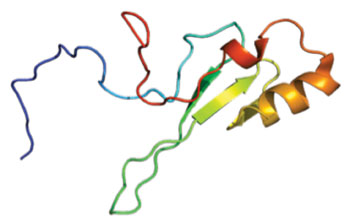DNA Reference Samples Will Regularize Diagnosis of Rett Syndrome
By LabMedica International staff writers
Posted on 26 Feb 2014
A panel of highly characterized DNA samples that identify mutations in the gene that encodes methyl CpG binding protein 2 (MECP2) are now available to clinical laboratories as reference material for the diagnosis of Rett syndrome (RS).Posted on 26 Feb 2014
Rett syndrome is a dominant X-linked disorder caused by point mutations (approximately 80%) or by deletions or insertions (approximately 15% to 18%) in the MECP2 gene. It is most common in females but lethal in males, with a distinctly different phenotype. Female Rett syndrome patients have severe neurological and behavioral problems.

Image: Structure of the MECP2 protein (Photo courtesy of Wikimedia Commons).
MECP2 appears to be essential for the normal function of nerve cells. The protein seems to be particularly important for mature nerve cells, where it is present in high levels. The MECP2 protein seems to be involved in silencing several other genes. This prevents those genes from making proteins when they are not needed. Recent work has shown that MeCP2 can also activate other genes. The MECP2 gene is located on the long arm of the X chromosome. MECP2 gene mutations are the cause of most cases of Rett syndrome, a progressive neurological developmental disorder, and one of the most common causes of mental retardation in females.
Currently there are no US Food and Drug Administration-approved assays for Rett syndrome. Therefore, laboratories have had to develop their own tests but have lacked reference materials to standardize their techniques, validate assays, and meet regulatory and accreditation requirements.
To make up for this lack investigators at the Centers for Disease Control and Prevention (CDC; Atlanta, GA, USA) collaborated with members of the clinical-laboratory and nonprofit–research communities to develop a set of well-characterized DNA samples to standardize Rett syndrome testing.
DNA samples from 35 cell lines were tested in accordance with the CDC's Genetic Testing Reference Materials Coordination Program (GeT-RM) by eight clinical genetic testing laboratories using DNA sequence analysis and methods to assess copy number (multiplex ligation-dependent probe amplification, semiquantitative PCR, or array-based comparative genomic hybridization). The eight common point mutations known to cause approximately 60% of Rett syndrome cases were identified, as were other MECP2 variants, including deletions, duplications, and frame shift and splice-site mutations. Two of the 35 samples were from males with MECP2 duplications.
These MECP2 and other characterized genomic DNA samples are publicly available from the CDC's Coriell Cell Repositories.
"The panel of 35 publicly available genomic DNA samples developed and characterized as part of this study contains a wide variety of point mutations, deletions, and duplications in both male and female samples that can be used by clinical laboratories to ensure the quality of Rett syndrome testing," said first author Dr. Lisa Kalman, a researcher in the division of laboratory programs, standards, and services at the Centers for Disease Control and Prevention. "The availability of a renewable source of characterized reference materials for Rett syndrome will help to ensure the accuracy of these genetic tests and facilitate research and test development."
"Molecular diagnosis of Rett syndrome is performed by examination of patient DNA for MECP2 mutations using a variety of molecular diagnostic methods," said Dr. Kalman. "Genetic testing can help to confirm or establish the diagnosis of RS, especially when patients are young and the phenotype may not be completely apparent. Testing may also be important for at-risk relatives, prenatal diagnosis, or evaluation of an embryo prior to implantation during in vitro fertilization."
The study was published in the February 10, 2014, online edition of the Journal of Molecular Diagnostics.
Related Links:
Centers for Disease Control and Prevention














